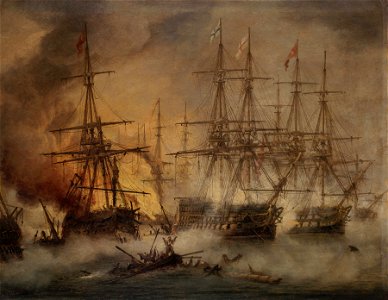The battle of navarino, 20 october 1827
following the treaty of london in 1827, the signatories - britain, france, and russia - were committed to enforcing peace in the greek archipelago, where greek patriots were attempting to throw off ottoman rule. Greece agreed to an armistice but turkey did not. Vice-admiral sir edward codrington, the british naval commander-in-chief in the mediterranean, prevented the turks supplying their troops in greece and closely watched the turco-egyptian fleet in the bay of navarino (pylos) on the west coast of the peloponnese. On 21 september, codrington was joined by the french squadron commanded by rear- admiral henri de rigny and on 13 october by the russian squadron under rear-admiral count heiden. Early in october the turks made two attempts to ship troops to patras, where lord cochrane was fighting on the side of the greeks. Codrington decided to move into the bay but was prevented by the direction of the wind from doing so until 20 october. As the fleet entered the bay a turkish boat pulled alongside codrington's flagship, 'asia', 82 guns, with a message from ibrahim pasha to say that he had not given permission for the allies to enter and instructed them to leave. Codrington refused and the ensuing battle continued for four hours, resulting in the virtual destruction of the turkish fleet, although the allies did not lose any ships. It was the last fleet action fought under sail and made codrington a popular hero, though not with the british government which considered he had exceeded his instructions and recalled him. Thomas luny's interpretation of this battle is believed to be taken from plate 4 of a set of four lithographs of the battle. These relate to a large painting of the battle also in the msueum collection (bhc0623) by george philip reinagle, a young marine artist who was a guest in the mediterranean fleet and present at the action. In the centre foreground of luny's painting, an egyptian boat in starboard-bow view behind the ships at anchor, contains gesticulating figures. All around it are people in the water and a broken mast floats to the right. Beyond this, slightly right of centre, is the 'asia', starboard-quarter view, with her anchor visible and figures in the rigging. She is in close action to port with the flagship of the egyptian admiral, mocharem bey; the bows of which, in starboard-bow view, are to the right of the 'asia'. In the left of the picture, in starboard-bow view but almost bow on, is the flagship of the turkish admiral, capitan bey, much shattered and on fire. Between her and the 'asia' is another burning ship and in the extreme left foreground can be seen part of the port side of the 'genoa'. The smoke of battle pervades the scene. The artist has inscribed the painting on a floating spar on the far left, 't luny 1828'. The battle of navarino, 20 october 1827. Object Type: painting. Genre: marine art. Date: 1828. Dimensions: Painting: 406 mm x 521 mm; Frame: 567 x 674 x 70 mm. Medium: oil on canvas. Collection: Royal Museums Greenwich. The Battle of Navarino, 20 October 1827 RMG BHC0622
Loading...
